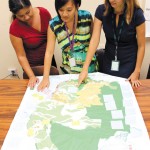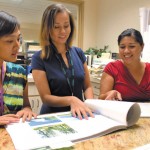Planning Kauai’s Future
County planning director Michael Dahilig and long-range planners (pictured at left) Lea Kaiaokamalie, Marisa Valenciano and Marie Williams are actively looking at how to make Kauai a more liveable island
Owning a home on Kauai is a pipedream for a significant portion of the island’s population. In fact, 60 percent of the housing inventory is affordable to less than 25 percent of residents.
- County planning director Michael Dahilig and long-range planners Lea Kaiaokamalie, Marisa Valenciano and Marie Williams are actively looking at how to make Kauai a more liveable island
- Director Michael Dahilig with long-range team (from left) Marisa Valenciano, Marie Williams and Lea Kaiaokamalie at the window of the Planning Department in Lihue
- The Lihue Urban Town Core Plan was one of the many things Valenciano, Williams and Kaiaokamalie have been working hard to finalize
His team of long-range planners — Lea Kaiaokamalie, Marisa Valenciano and Marie Williams — is working diligently to update the county’s development plans and diversify neighborhoods into more functional and affordable areas. Because despite the popular misconception that the majority of growth is from people moving to Kauai, the reality is that the community is growing because of an increasing number of keiki.
The Planning Department’s long-range division creates community plans that provide direction for the county. The original development plans were crafted in the 1970s and were divided into six districts. The team currently is in the process of finalizing updates on three of them — South Kauai, Lihue and East Kauai. They have been looking closely at each of these districts and have conducted numerous meetings in the corresponding communities to gather input from residents about how they envision a future Kauai. The proposals are slated to be heard at an upcoming public Planning Commission meeting and have taken what were once automobile-dominant neighborhoods and transformed them into places where people can live, eat, work and play affordably.
“It’s really exciting right now,” says Valenciano.
If plans are approved, they will become guides for future land use, capital improvements, building amendments and other county actions.
“They’re like cookbooks, essentially. They give you the lay of the landscape as to how you want your community to look, and here’s what you’ve got to do,” explains Dahilig.
Lihue is one area that already is experiencing changes and where critical growth is expected to continue. Revitalizing the town core to create a more walkable and accessible community is underway.
“Through the process alone, people got inspired to start to implement some of these good ideas,” says Kaiaokamalie. “Hopefully, that will encourage other businesses to come into the area and create a lively town core that we all want to see.”
Kauai Beer Company provides an example of Rice Street’s potential, a place for people to not only work, but to unwind pau hana. “We see them as an opportunity to show what kind of cool places can be created on Kauai,” says Dahilig.
In addition, the Lihue Town Core Urban Design Plan (a part of the Lihue Community Plan) includes the progressive Complete Streets Program and adjusted zoning to grant mixed-use development with greater building heights that would allow a developer to put businesses on the ground floor and residences above.
“Our job is not necessarily to say what should go into the buildings, but how to facilitate the land around them or the streets to encourage those types of businesses to locate in these areas,” explains Kaiaokamalie.
South Kauai also is expected to grow. Visitors are projected to continue gravitating toward the Poipu resort hub, which means an increase in job opportunities for kamaaina. Land-use changes intended to accommodate housing for the working class, such as duplexes, are part of the plan’s proposals, and the idea is for new developments to mimic the historic plantation look.
East Kauai, which has seen tremendous growth in the past two decades, also has a proposed plan for areas of growth and development and, of course, attempts at alleviating traffic woes.
There couldn’t be three people more suited for the job of helping Kauai become more street and neighborhood savvy. Kaiaokamalie, Valenciano and Williams each have personal ties to the Islands.
Kaiaokamalie (Waimea High School) and Valenciano (Kauai High School) were born and raised on the island. Kaiaokamalie earned her master’s in urban and regional planning at University of Hawaii in 2000.
“My intent was always to come home and do this because I love my family and this is important,” says Kaiaokamalie.
Valenciano has degrees in planning, public policy and management, and political science from the University of Oregon.
“It’s an honor to be able to serve my hometown and be able to do the work and see it being applied,” she says.
Williams is originally from Oahu and achieved her master’s in urban and regional planning from Georgia Institute of Technology after volunteering for the Peace Corps in West Africa, where she worked with farming communities.
“Seeing people come together who can’t even afford to buy shoes, working hard to improve their lives, especially for their children — I realized there’s power in that and I wanted to come back home to Hawaii to do that,” she says.
Together, they make a good team. “I’m proud of the team because no matter how frustrating it is to take a vision and get it down to something that is solid, that will move to actuation, no matter how tired we get or how bogged down, we still come together and try to figure things out and move on with our responsibility,” says Kaiaokamalie.
“There’s something about the ability to create great places for people,” agrees Dahilig.
To check out the plans online, visit kauai.gov/Government/Departments/Planni ngDepartment/LongRangeDivision/tabid/541/Default.aspx.
cocomidweek@gmail.com






